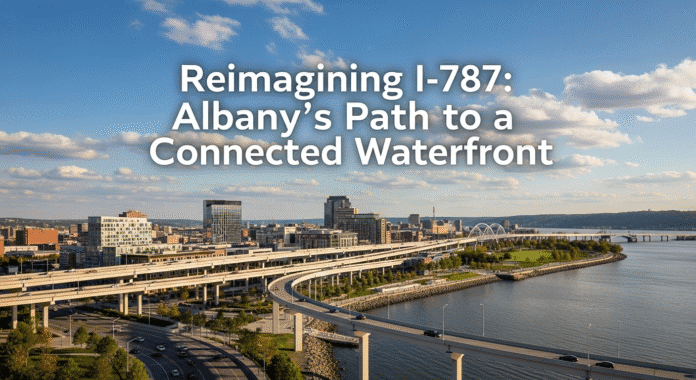How the I-787 Corridor Study Could Transform Albany’s Future
The Interstate 787 Corridor study is paving the way for a new era in Albany. The New York State Department of Transportation (NYSDOT) has unveiled plans that could reconnect the city with its iconic Hudson River waterfront while transforming a once-divisive highway into a vibrant, community-focused landmark. With proposals ranging from boulevard conversions to the complete removal of elevated structures, this project promises to redefine Albany’s landscape and quality of life. Read on to discover how these bold ideas could reshape the city, improve safety, and stimulate local growth.
What Is the I-787 Corridor Study?
The I-787 Corridor Planning and Environmental Linkages (PEL) study is a landmark initiative designed to address critical transportation and safety issues along a nine-mile stretch of highway in Albany. This effort aims to overcome decades of division between Albany and the Hudson River. Key objectives include:
- Enhancing access for vehicles, pedestrians, and cyclists
- Reconnecting historically divided neighborhoods
- Supporting downtown revitalization and economic growth
- Addressing aging infrastructure and safety concerns
By evaluating these needs through multiple design proposals, NYSDOT is exploring how to best transform this corridor into a catalyst for community and economic development.
The Five Plans to Reimagine I-787
NYSDOT has put forward five distinct proposals to reimagine the I-787 corridor. Each plan is crafted to improve Hudson River access and community connectivity while balancing overall transportation needs.
1. Maintain and Enhance the Existing Corridor
This option emphasizes preserving the current highway structure with targeted improvements. Minor modifications are planned to improve pedestrian and bicycle access without fundamentally changing the highway’s layout. Although this approach is less disruptive, its transformative impact on waterfront connectivity is limited.
2. Partial Removal of Elevated Structures
This proposal calls for removing select elevated sections of I-787 to create open spaces and public areas. The removal would not only reduce the physical barrier separating Albany from the Hudson River but also allow for the creation of parks and greenways that foster community engagement while managing traffic flows responsibly.
3. Boulevard Treatment Options
Three of the proposed plans involve converting parts of I-787 into a surface-level boulevard. This approach is designed to:
- Replace elevated roadways with at-grade, tree-lined streets
- Slow traffic speeds to improve pedestrian and bicycle safety
- Reconnect neighborhoods by reducing the visual and physical divide created by the highway
A notable concept envisions transforming the South Mall Expressway into a two-block boulevard stretching from Pearl Street to Empire State Plaza. This design not only enhances safety and accessibility but also provides a fresh urban aesthetic that integrates the historic fabric of downtown Albany with its natural surroundings.
4. Full Removal of I-787
The most radical plan envisions completely removing I-787. Traffic would be rerouted along alternative paths, opening up vast public spaces for development. While this option offers the promise of maximum riverfront access and neighborhood reconnection, it also entails significant challenges in traffic management and funding.
5. Hybrid Approach
A balanced solution combining elements of the above plans, the hybrid approach tailors interventions to specific sections of the corridor. By integrating limited elevated structure removal with boulevard conversion in targeted areas, this proposal seeks to address both transportation efficiency and community needs.
The Dunn Memorial Bridge: A Gateway to New Possibilities
A key element in several plans is the redesign of the Dunn Memorial Bridge, which currently serves as a critical link between Albany and neighboring communities. The new design would collapse the existing multi-level structure into a single-plane urban interchange. This transformation would facilitate wider pedestrian and bike paths and improve overall safety by simplifying traffic flow.
Greg Wichser of NYSDOT explained, “By replacing the Dunn Memorial with this option, a single point urban interchange, this would collapse the stack into a single plane, still elevated, which then leads to the South Mall expressway could run downhill and touch down at grade at Pearl Street and become a boulevard for two city blocks between Pearl Street and the Empire Plaza.” This vision positions the bridge as not only a passage for vehicles but as a dynamic gateway linking the city with its vibrant waterfront.
Reconnecting Albany with the Hudson River
For decades, the construction of I-787 isolated Albany from the Hudson River, cutting off access to one of the region’s most treasured natural resources. The I-787 Corridor study is driven by a desire to bridge that gap once again. Enhanced riverfront access would enable the creation of new public spaces, parks, and greenways that invite residents and visitors to experience the beauty of the Hudson River firsthand.
Senator Pat Fahy, a tireless advocate for reconnecting Albany with the river, remarked, “Today represents a major milestone in the ongoing process to Reimagine 787 and reconnect Albany with its greatest natural and historical asset, the Hudson River. We are finally charting a new, resident-driven course for our Capital Region.”
These initiatives are expected to bring economic revitalization to downtown Albany. Improved access to the riverfront will not only boost tourism but also stimulate local business growth and community events, transforming the area into an attractive destination for both residents and visitors.
Community Voices: Hopes and Concerns
A project of this magnitude sparks strong emotions across the community. NYSDOT has engaged in extensive public outreach, hosting open houses, community meetings, and online forums to gather diverse perspectives.
Public Hopes
Residents and stakeholders are excited about the prospect of:
- Reclaiming access to the Hudson River
- Creating safer, more inviting streets for walking and biking
- Revitalizing neighborhoods and downtown areas that have long been divided by the highway
- Generating new economic opportunities and fostering community pride
Public Concerns
Despite the optimism, several issues remain under discussion:
- Traffic disruptions during construction have raised concerns about daily commutes and the overall efficiency of the region’s transportation network.
- The project’s cost—estimated to range from $2.8 billion to $6 billion—has sparked debate over funding priorities.
- Some community members remain skeptical about whether the promised long-term benefits will materialize, particularly in light of past infrastructure projects that fell short of expectations.
NYSDOT officials assure the public that extensive efforts will be made to mitigate these concerns through phased construction, ongoing stakeholder engagement, and transparent planning processes.
Addressing the Challenges
Recognizing the magnitude of change required, NYSDOT is taking several steps to balance innovation with practicality:
- Phased Construction: The gradual implementation of project components is intended to minimize disruption. This approach allows for adjustments based on community feedback and real-time challenges during construction.
- Transparent Communication: Regular updates, public meetings, and easily accessible planning materials ensure that residents and local businesses remain informed every step of the way.
- Extensive Public Engagement: Together with state and local leaders, NYSDOT is making sure that each voice is heard. This collaborative process is vital for shaping a project that truly benefits all sections of the community.
- Environmental Reviews: A rigorous two-year environmental review process is being initiated to ensure that any changes will enhance, rather than harm, Albany’s overall quality of life.
Governor Kathy Hochul has already set aside $40 million in the fiscal year 2026 state budget to advance these preliminary steps, a signal of the political will behind this transformative initiative.
Counterarguments and Ongoing Debate
Critics caution that the extensive changes required by the I-787 project may lead to significant short-term disruptions. Concerns over long-term traffic management and budget overruns continue to be voiced in local forums. However, project proponents maintain that the long-term benefits—improved connectivity, environmental gains, and economic revitalization—will far outweigh the temporary inconveniences and significant costs.
NYSDOT Commissioner Marie Therese Dominguez stated, “There is limitless potential for improving the I-787 corridor in terms of safety, connectivity, and improved access to the Hudson River – one of the true national wonders of the Empire State.” This balanced perspective aims to address both the enthusiasm and the valid concerns expressed by the community.
What’s Next for I-787 and Albany?
The release of the PEL study marks the beginning of an intensive two-year environmental review. During this period, additional public input will be integrated into the refining of project plans. The final project will be shaped not only by detailed engineering and significant political support but also by the active involvement of Albany residents who stand to benefit most from these changes.
Governor Hochul encapsulated the project’s promise by asserting, “Talk about reimagining nine miles of that waterfront and connecting the people of this great city to that magnificent body known as the Hudson River, and we’re going to get it done.” With construction potentially spanning up to nine years, this is a once-in-a-generation opportunity to transform Albany in a way that will serve future generations.
A Call to Action
Reimagining I-787 is far more than a transportation upgrade; it is a visionary plan to end the longstanding separation between Albany and the Hudson River. With options ranging from minor enhancements to complete removals, the project promises to reshape the region’s urban fabric for the better. As construction plans evolve and community engagement deepens, Albany has the chance to set a new standard for urban renewal and connectivity.
Stay informed about the developments in this transformative project. Share your thoughts, join public discussions, and help shape the future of Albany’s waterfront. Together, we can build a more connected, sustainable, and vibrant city.




